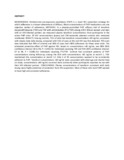| dc.description.abstract | BACKGROUND:
Antiretroviral pre-exposure prophylaxis (PrEP) is a novel HIV prevention strategy for which adherence is a known determinant of efficacy. Blood concentrations of PrEP medications are one objective marker of adherence.
METHODS:
In a placebo-controlled PrEP efficacy trial of tenofovir disoproxil fumarate (TDF) and TDF with emtricitabine (FTC/TDF) among 4747 African women and men with an HIV-infected partner, we measured plasma tenofovir concentrations from participants in the active PrEP arms: 29 HIV seroconverters (cases) and 196 randomly selected controls who remained uninfected.
RESULTS:
Among controls, 71% of visits had tenofovir concentrations >40 ng/mL, consistent with steady-state daily dosing, compared with 21% of cases at the visit HIV was first detected. Pill count data indicated that 96% of controls and 66% of cases had >80% adherence for these same visits. The estimated protective effect of PrEP against HIV, based on concentrations >40 ng/mL, was 88% (95% confidence interval: 60 to 96, P < 0.001) for individuals receiving TDF and 91% (95% confidence interval: 47 to 98, P = 0.008) for individuals receiving FTC/TDF. Controls had consistent patterns of PrEP concentrations during follow-up; among the 81% with concentrations >40 ng/mL at month 1, 75% maintained this concentration at month 12. Only 5 of 29 seroconverters seemed to be consistently adherent to PrEP. Tenofovir concentrations >40 ng/mL were associated with older age and shorter time on study; concentrations ≤40 ng/mL occurred more commonly when participants reported no sex with their HIV-infected partner.
CONCLUSIONS:
Plasma concentrations of tenofovir consistent with daily dosing were highly predictive of protection from HIV acquisition. Most of those who took PrEP seemed to have high and consistent adherence. | en_US |

